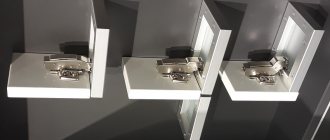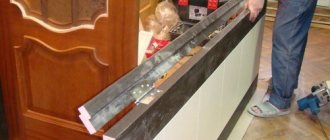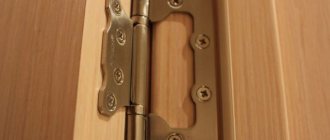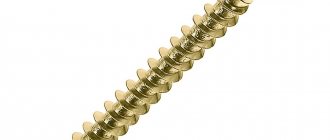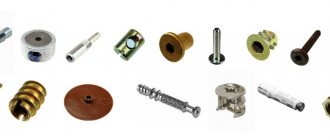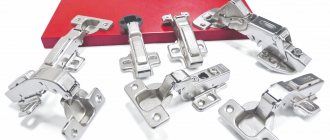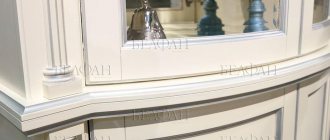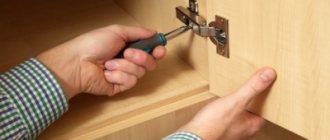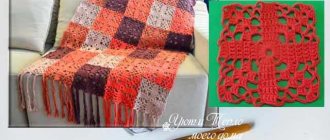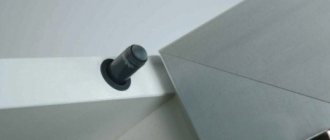Many home craftsmen prefer to make furniture with their own hands. A cabinet or stool assembled in a garage is sometimes in no way inferior in quality to a factory-made product. If the master has the tools and skills, of course.
Moreover, homemade furniture is much cheaper. A sheet of laminated chipboard is relatively inexpensive. With proper sawing, you can make a cabinet and several stools, and maybe more, from one blade. The only question is the size.
But to make furniture, in addition to the above-mentioned skills and tools, you also need special equipment. Various types of conductors and templates for marking, which greatly facilitate the work.
For example, in order to install hinges when assembling cabinet fronts, it is necessary to make the most accurate markings for the strike plates and hinge cups. That's what a template is for. It can, of course, be purchased in a store or online. But in small towns or villages, due to the remoteness, purchasing such devices is very difficult.
Marking for loop
An important part of the correct installation of any furniture hinges is, of course, the most accurate markings. If it is done poorly, it will certainly affect the functionality of the door.
The correct markings for furniture hinges will help you find the right center to make the recesses.
You need to “move away” 7-12 centimeters from the edge. The number of hinges is standard two, but it can vary depending on the type of furniture. It is necessary to maintain a specific distance between the loops. It is equal to fifty centimeters. The door parameters depend specifically on the number of canopies.
When you have finally decided on the quantity and all the necessary dimensions of furniture hinges have been installed, you can mark the central holes in relation to the width of the door. The distance from the side should be approximately two centimeters. It is also impossible not to take into account that the fastening should not be placed where the shelves in the closet or cabinet should be.
After taking all the necessary measurements, make notes. Remembering to respect the width spacing, mark the placement point. At the intersection of these marks, you need to make a “hole” with a nail or a self-tapping screw. If the facade is higher than a meter, make notes every half meter.
For more precise marking, you can use a special template called.
Loop insertion order
1. Mark the furniture door based on the recommended distances between the hinges.
2. Using the stopper against the end, place the template on the door and secure it with a clamp.
3. Place the router in the work area, lower the tool body until the cutter touches the surface of the workpiece and clamp the locking lever.
4. Lower the depth gauge to the position support.
5. Count 11.5 mm on the scale and set the stopper position.
6. Tighten the routing depth adjuster lock.
7. Adjust the parameter using a micrometer screw.
8. Release the locking lever.
9. Rotate the positioning support to set the depth of the first pass.
10. Start the router, press the body and fix the position. Smoothly moving the tool along the surface to be processed, cut out the material, starting from the circle and moving to the center.
11. Once you have completed the passage, release the latch. Rotate the support to the next position and repeat the process until the recess is completely exhausted.
Advice. If there is no sawdust removal system, it is recommended to clean the work area with a vacuum cleaner after each pass to avoid milling defects.
12. A neat seat is ready.
13. Insert a loop into the recess, align and mark the location of the screws.
14. Drill for screws, limiting the drilling depth.
15. Screw the hinges with countersunk screws.
Read also: Bending equipment for sheet metal
After inserting the hinges, proceed to the door hanger, for which mark the location of the mating parts. In our example, the markings for the screws are 37 mm from the end of the chipboard. For other modifications of the fittings, determine the size locally: having assembled the hinge and positioning the front adjustment screw in the middle, lean the door against the side with a gap of 2 mm and place marks through the oblong holes. Complete the work with adjustment operations.
Adjustment screws: 1 - height; 2 - in depth; 3 - in width.
In a similar way, it is easy to calculate and make templates both for installing cup hinges of other sizes and for cutting other holes.
The furniture hinge has a cup on one side that cuts into the door mass. The standard cup diameter is 35 mm. To install the hinge yourself, you need to get a forstner drill and do the following:
Place the door against the cabinet body and mark with a pencil where it joins the shelves. Measure in several places at right angles from the edge of the door 22 mm. Connect the points into one line. Mark the centers of the recesses at a distance of 10 cm from the top and bottom of the door slab. If the points coincide horizontally with the shelves inside the cabinet, move them vertically. With the slab on the floor or workbench, carefully use a forstner drill bit (ø 35 mm) to make recesses
This must be done very carefully so that the drill does not come out. The best option is to purchase a drill with a stop; it will stop at the desired depth. As you drill, insert the cup of the hinge into the groove until, when you press on the transverse bars with holes, they swing
When working with a limiter, this is not necessary. Lower the hinge cups into the openings so that the line of the slats' holes is strictly parallel to the side edge of the door. Secure the hinges with screws. Lean the door against the body so that the hinge arms are against the cabinet wall. Screw the fasteners through the holes in the second half of the hinge. Two hinges are installed on the doors of wall and floor cabinets. In the case of installing a door leaf of a pencil case with a height of more than a meter, three hinges are installed.
When installing double-leaf hinges, you need to determine the thickness of the plates. Usually this size does not exceed 2 - 3 mm. Having determined the attachment points on the end surface of the side pillars of the door frame, attach the hinge halves to the wood and trace the outline of the plate with a pencil.
Detachable hinges can be left or right. Their correct location should be as follows: the plates with the pin are mounted in the cabinet opening with the axis up. The door hinge plates are installed with the sockets facing down.
At the end of the door where the hinge is installed, mark the thickness and length of the plate. Carefully remove excess wood with a chisel. If you own a hand router, then the recesses for the hinges can be made easily and quickly.
Having placed the plate at the installation site, use a pencil to outline the holes for the screws. Having removed the loop, use a drill with a thin drill to make shallow holes (5 mm) at the marking points. Using a screwdriver, you can easily secure the hinges with self-tapping screws on the doors and cabinet body.
Adjustment
Adjustment (or adjustment) is the final stage of installation of furniture hinges. It must be performed in several planes at once - vertically, horizontally, and in relation to depth:
- Adjusting the depth will help press the door closer to the body, or ease the pressure. You need to tighten the oval hole.
- On the vertical side - it will help to move the facade. This is done by twisting oval-shaped holes.
- On the horizontal side - ensures free movement of the door back and forth and back. The purpose of this adjustment is to avoid gaps between the cabinet and the door. The method is great for rooms with uneven floors or walls.
Now you know how to secure furniture hinges. As you can see, this is not so difficult to do. You don't need to have any special skills or abilities. Doing this kind of work with your own hands will be another reason for a little pride.
The nuances of installing furniture hinges on a glass cabinet door
Similar to chipboard furniture hinges with a 26mm bowl, special furniture hinges for glass doors are installed. Using the adjusting screws, you can align the facades in the “left-right” position up to 5mm, “top-bottom” up to 2mm and “closer-further” from the frame up to 2.5mm.
| A plastic bowl with a seal is inserted into the pre-drilled hole, and the hinge arm is snapped into it. |
| The strike plate is installed to the desired depth with an internal glass facade and to a depth of 37mm with an overhead hinge for a cabinet. |
| Next, to install the hinge on the glass cabinet door, you need to thread it through the striker plate and secure it with adjusting screws. |
The canopy adjustment for the glass door is made in the same way as for all four-hinge hinges. After alignment, a special plug (metal or plastic) is placed on the outside of the bowl mechanism.
Since glass with drilling is quite fragile, it is recommended to install additional dampers (closers) to soften the impact of the door on the body. You can implement a push-opening system by installing a magnetic pusher with applied metal handles on the top or bottom edge of the glass door.
Other types of loops
So, all types of loops can be classified in different ways. Thus, there are different types according to design, purpose, method of fixation and application. In general, there are several dozen types of furniture hinges, some are more common, some are less common, but almost all find application in various types of furniture designs. In addition to four-hinged hinges, let's look at a few more variations of hinges that may be encountered by furniture assemblers or people who have bought new interior items and decided to assemble them themselves.
Card loop
Card loops are considered the oldest. Their ancestor is a forged hinged hinge with a long overlay. Outwardly, they resemble an ordinary door hinge, only slightly smaller in size. The design consists of two metal strips connected in parallel using a thin rod that acts as a hinge. Nowadays they are rarely used, but are indispensable in the manufacture of retro-style furniture.
Butterfly door hinges
Pendulum type hinges or bar hinges make it possible to open the door 180 degrees. What happens is something similar to how the doors open at the entrance to a saloon in old westerns.
Bar loop
Mezzanine hinge structures are designed to attach horizontally oriented doors that will open upward. The hinges have a spring mechanism and also allow you to fix the door when open. They resemble ordinary overhead variations of loops.
Mezzanine hinge MK01
Ombre structures are used for so-called hinged doors. They will be mounted on both ends of the cabinet and do not require insertion, but may require minor milling (up to 2 mm). Then the sash can be opened 180 degrees. This is an ideal hinge for a folding table.
Hinge for folding elements
Secretory structures are similar to the card ones described above; they have an axial hinge and plates. They make it possible to open the façade downwards and keep it in a horizontal position. They can be accompanied by a special bracket that provides a supporting function. Usually installed in those cabinets where a bar is provided.
Secretory loops
Blind hinges, otherwise called adit hinges, are used for doors on the side of the cabinet that is adjacent to the wall. They can be used to attach the door to the false panel.
Gallery hinges
Heel products are extremely rarely used because they are designed only for lightweight doors. But they can be installed on facades with any type of opening. Installation is carried out in the lower and upper parts of the sash.
Heel loops for furniture
There are special hinges for glass sashes. They also come in different types, but their advantage is that they can withstand significant loads, and they look very beautiful.
Glass hinge
And relatively recently, hinges with 8 hinges, eight-hinged, appeared on sale. To install them, you do not need to resort to milling or cutting. This is an improved variation of the usual four-joint hinge. True, they are more difficult to install, and therefore, despite the absence of the need to carry out any preparation, such loops are rarely used.
8-joint hinge
Furniture hinges: features and types
A furniture hinge is a semi-mechanical design that makes it possible to open and close part of the furniture body (usually a door), retracting it to a certain angle. It is completely invisible from the outside, but at the same time it is capable of not only holding it in the desired position and helping to open the facade (door), but also preventing it from opening without permission. Typically, hinges are used for the so-called hanging of doors made of various materials - wood, glass, aluminum profile. Also, most hinges are capable of closing on their own. The most common type of hinges is four-hinged . They are highly functional and very reliable, durable and can serve for many years without breaking.
Four-joint furniture hinge
On a note! For the first time, a design that can close on its own appeared only in the twentieth century; it was patented in Italy.
History of furniture hinges
The design of a furniture hinge is represented by the following elements.
- The base or base is the element that is attached to the mounting plate. It has a special screw that makes it possible to adjust its position.
- The cup is a part that, during the installation of hinges, is installed in a hole specially drilled in the facade. It has a round shape.
- Hinges are movable elements equipped with spring mechanisms.
Furniture hinge - structure
Each hinge of this type has a spring that allows the design mechanism to hold the cabinet door closed and prevent it from opening without permission. These hinges can be adjusted in three planes at once, which is very convenient and allows you to adjust them perfectly in almost every case. They are made of steel and have high protection against rust.
On a note! Such loops in Russia are also called cup loops or a more prosaic name - frog.
What is it and how does it work?
Hinges with four hinges can be:
- semi-overhead , which are usually used if you need to attach a pair of sashes to one side at once, which will open in different directions. That is, the facade covers only part of the end;
- overhead , which are suitable for installing the door on any side of the body;
- angular , which must be used if the door must be attached at a strictly defined angle (for example, 45, 90 or more degrees). As a rule, the angle depends on the design features of the cabinet;
- inverse , which make it possible to open the door 180 degrees, that is, when the door is opened, one plane is formed with the base wall;
- inset or internal , which allow you to secure the door inside the cabinet. The loop resembles a half-overlay, but is more curved.
Types of furniture hinges
In fact, there are not only four-hinge hinges, although they are the most common and are most often used during furniture assembly to connect the frame to the doors. There are also other varieties that we will now get acquainted with.
Making your own template
Making a template for furniture hinges with your own hands follows a clear plan
It is important to follow the sequence of steps. If you follow all the rules, then there will be no difficulties in the process.
Stages of developing a template for loops:
- Selection and preparation of materials;
- Preparation of necessary tools;
- Development of template details;
- Final assembly of all elements.
Paper template for download
- To create a template yourself, you need to print a sample.
- According to its dimensions, make a blank from solid material, plastic or wood
- Attach the paper template to the workpiece
This is what should happen
To create a workpiece you will need to take a drill, router, hammer, jigsaw. You will also need tools for drawing markings. First you need to make a base. The optimal dimensions are 19x38 cm. A hole measuring 13.5x7 cm should be made in the center. The edges should be smooth. A router will help with this.
Bolts need to be placed on the workpiece
It is important to maintain symmetry relative to the width of the base. The bolts must be deepened into the structure so that they do not interfere with further manipulations
The hole is made wider than the connecting elements and additionally driven in using a hammer.
It is necessary to retreat 7 mm from the 13.5x7 cm holes and make small notches. Around an element with dimensions of 37.5x7 cm, notches are made on one side at a distance of 30 cm from each other.
A homemade template requires a holder measuring 2x5 cm and a length of 5.8 cm. You will need to install a limiter on one of the sides, which looks like a small block. This element will not allow the distance to shift when installing the facade.
Then all parts of the template are attached. Washers are installed under the bolts and nuts. This element increases the durability of the template. The manufacturing process does not require special skills or knowledge. It is enough to familiarize yourself in detail with the template development scheme.
Selection of materials for work
For the template, you can use plywood, chipboard or MDF. More durable structures are made of plexiglass and metal. You can take several materials for one template. So you can use chipboard for the base, and make the guides from a more durable material. It is easier to work with wood, as it is easier to process than glass and metal.
Required connecting elements:
- Bolts. You will need 6 pieces with a thickness of 6 mm and a length of 30 mm. To fix the connecting element, you need to have a 10 key.
- Nuts. Need 6 pieces. The main requirement for the element is convenient adjustment. Wing nuts are most often used.
- Washers. Their diameter should be 6 mm.
- Self-tapping screws. They are selected depending on the thickness of the remaining connecting parts.
DIY furniture conductors and templates
How conductors are made is now clear, as is their necessity for furniture production.
Not only conductors, but also templates are needed in furniture production. The simplest template will sometimes save a lot of time and allow drilling to be no less accurate than a jig.
For example, the simplest metal prefabricated template, consisting of two sheet blanks measuring 130x70 mm and a steel square with a cross-section of 20 mm. They are connected to each other by screws at the top of the structure - this is how they are attached to the square. The square is drilled for the bushings, where the latter are pressed. Such a device for drilling holes in the end of a part made of chipboard will make it possible to drill without thinking about marking and perpendicular drilling. And the price of this equipment is below any idea of savings.
Instead of metal, you can and should use those materials that are inexpensive and easy to process.
- Plywood.
- Textolite or fiberglass - preferably thick.
- Hardwood.
- Hardboard or its equivalent.
It must be borne in mind that these materials are short-lived, and so that the devices do not have to be made every day, it is quite reasonable to press metal tubes into them.
In conclusion, it is worth summing up what has been said. Making a conductor or template yourself or buying it in a store is a matter for everyone individually. If a home craftsman needs to make some furniture in a single copy and there is material for a conductor, as well as the possibility of making it, you can use this. It is possible that such equipment will never be useful to the master again.
But if even a small furniture workshop is engaged in the production of mass-produced furniture, and it employs enough people, it is probably easier to purchase something ready-made, especially since they will need these indispensable assistants to the craftsmen in several copies.
In the latter case, it makes sense to purchase more expensive, accurate and wear-resistant jigs instead of making homemade ones, which are less accurate and durable.
Description
A furniture jig is a special template tool that is often used by specialists in small and large enterprises to mark drilling points on products and, in some cases, also ensures that the drill fits straight into the material. Depending on the needs of the master, conductors can be either factory-made or self-made. Most often they take the form of a metal template with sleeves for the hole and marking the distance between them. The main advantage of using a furniture jig is that specialists spend less time taking measurements and making markings for drilling.
Using it, you can quickly mark the necessary points on the product blanks, and then make their high-quality connection using different fastening methods. The scope of its application is quite wide, but most often it is used for quick insertion of standard furniture hinges. The device may vary in appearance and markings on the template depending on its intended purpose and operating conditions. For example, a jig for furniture hinges in the production of doors will differ significantly in appearance from a jig that is used to fasten massive furniture doors.
Other uses
Hole jigs are used not only in furniture production. Quite often they are used when you need to make a hole in a pipe or other cylindrical part. Thanks to them, you can make a high-quality hole even in a pipe with a small diameter.
Read also: Comparison of natural and synthetic rubber
Such devices are universal and easy to use, so they are also used in the following industries:
- mechanical engineering - drilling holes in different-sized workpieces based on different materials;
- construction - drilling holes in building structures;
- home communications - as already mentioned, pipe drilling and more.
Modern drilling jigs can be of different sizes and have different operating principles. Some of them are complex, so they are easier to buy. And some modifications can be made independently, especially since some serial furniture models, especially those with universal purposes, are expensive.
Drilling holes
Installation is carried out with all the rules:
The depth of the hole for the furniture hinge should be about thirteen millimeters. If possible, the insertion of furniture hinges should not be deeper, otherwise the front side of the canvas may crack; The diameter of the hole depends strictly on the cup of the loop
Tools must be completely aligned with their axis to prevent damage to the surface; A sharpened cutter will help protect the blade from damage and chips; Do not rush while drilling, otherwise there is a risk of doing it sloppily; It is worth paying attention to the dimensions of the cups and their dimensions when installing furniture hinges;
Having drilled one hole, proceed to the next and so on until all the holes for laying the hinges are prepared.
What tools should I use for this?
The bowl must be secured to the facade, and the bar to the body of the bedside table. The furniture hinge must be inserted into the hole, which must be made in advance. The shoulder of the loop becomes a kind of bridge, now connecting both parts. To make holes for such loops, you need to prepare the following tools:
- screwdriver or drill;
- special drill-mill;
The diameter of the cutter for the hole for a furniture hinge is 35 millimeters or 25-26mm. It is selected depending on the size of the loop cups. To create holes for such hinges, you can also use a simple drill.
A multifunctional drill, with attachments that are easy to replace, is quite suitable for such work.
The middle spike must be installed in the center of the circle, outlined using a specially prepared caliber. Automatic calibration is used on the corresponding machines, but at home the master cannot do without a specialized electric tool.
During installation, hinges require a high level of care and precision. The chance to complete exactly the required niche is the most important advantage of the so-called Forstner drill. It can provide a stop that will prevent you from penetrating further than required. And the teeth of the drill do not allow it to deviate from the intended “course”. The end result is an almost perfect hole. And due to this, the cup fits into the recess quite tightly.
But the above-mentioned drill also has one significant drawback, which manifests itself when working with a solid piece of wood. This is low quality, which is to be expected if the instrument was not made in a factory. This is why you should choose tools exclusively from official companies. And, of course, don’t forget about warranty cards.
Depending on the type of panel you are working with, the cutter can get quite hot. Due to this, it can burn the edges and wood that is removed from the recess. That is why, when working with such a foundation, you should not forget about breaks in work. So that the drills have time to cool down at least a little. Working in three to four sets will be ideal.
Particular attention should be paid to breaks when working with MDF sheets. If the activity is carried out with chipboard sheets, parts made of strong alloys will be able to make recesses for hinges really quickly and without much stress
Self-installation of overhead awnings
Installing hinges is not difficult; anyone can do it. Therefore, it is not necessary to call a specialist to carry out the installation.
Step No. 1 – preparing tools
An important step when installing hinges is preparing the workplace and tools. For installation you will need:
- pencil with ruler;
- drill;
- cutter of appropriate diameter;
- screwdriver;
- set of screws;
- building level.
Fraser
The diameter of the cutter should be similar to the size of the cut part of the hinges
Step No. 2 – marking and preparation for installation
First you need to mark the area for the awnings, following simple recommendations.
- Hinges should be placed no closer than 2 centimeters from the edge of the door.
- The distance from the top and bottom edges of the loops should be no more than 12 centimeters.
- If more than two canopies are installed, the middle one must be placed strictly between the upper and lower ones.
- There should be no obstructions, such as shelves, in the places where the hinges will be located.
Making the marking is quite simple - you need to attach the loop to the desired location for further installation and outline it with a pencil.
If the distance between the hole and the edge of the door is too small, the furniture may be damaged during use.
Step No. 3 – installation process
The installation process of each loop occurs according to the following algorithm.
- First you need to put the cutter on the drill, then use it to make a hole on the prepared marking.
- Now you need to insert the canopy into the connector and check the tightness of the fixation. If everything is good, you can proceed to the next step.
- Using a screwdriver, make holes for the screws.
- Secure the loop in the socket with self-tapping screws.
- Screw the second part of the hinge to the door.
Installation work with hinges does not require much time or effort, you just need to follow the recommendations in the instructions
Prices for the range of drills
Drill
Such manipulations must be repeated with each installed loop. If all recommendations are followed, the fittings will hold the door securely.
Recommendations for installing furniture hinges
Fastening rules
Most often, no preparation is needed to connect parts made of wood using self-tapping screws - the screws can be screwed into the part without drilling a hole. For these purposes, use a Phillips screwdriver or screwdriver. You need to act smoothly and carefully, especially when working with oxidized screws (they are considered the most brittle).
The tool should be kept strictly in line with the screwing hardware. You should not try to screw the fastener into the knot - despite the fact that these are the densest areas, such fastening will be considered ineffective. If you plan to screw screws into high-density natural wood, it is recommended to pre-lubricate the hardware with laundry soap. It will act as a lubricant and ensure easier insertion of the fastener into the material.
It is worth considering that the screw should not go through the 2 structures being connected.
Before drilling, you need to apply markings, and then make a hole in the main part measuring 0.8 times the diameter of the screw. The depth of the hole must correspond to the screw-in base of the hardware. If the fasteners are thin, you can use an awl.
When drilling soft lumber, it is also possible to make holes by hand. To work with hard materials, drill a hole that matches the profile of the screw-in fastener. To make a recess you need a drill and a drill. It is best to use a countersink.
After the preparatory work, the screw is inserted into the hole. It must be strengthened in the material by twisting it clockwise with a screwdriver. In this case, the correct selection of hand tools is important. If you take a screwdriver that does not match the size, there is a high risk of damaging the slot on the head - in this case, it will be impossible to tighten the fastener. You can also fasten screws using electric or pneumatic screwdrivers. Their use makes work easier and speeds up the assembly process.
The final stage is installing stickers or plugs on the fastener heads. Such accessories are sold in a wide range of colors. Their main task is to camouflage fasteners. Thanks to the use of stickers, you can increase the aesthetics of finished furniture.
For more information on screws and self-tapping screws, see below.
Selecting a model for production
Conductors of industrial production can be highly specialized and universal. Templates of the first type are used to perform certain operations on typical parts. Universal devices are suitable for working with different materials and objects of various configurations.
Based on design features and functionality, conductors are divided into the following types:
- overhead - when used, they are applied to the surface in the desired area, fixed with clamps or held by hand. Used for drilling holes in flat parts;
- rotary - the working part moves in both vertical and horizontal planes. Used when working with elements of complex geometric shapes and to create holes, the axis of which must be located at an angle;
- tipping - used to create holes in perpendicular planes.
A marking jig is used to mark the locations for drilling holes. It is much thinner and lighter.
The conductor device can be specially created for a certain type of fastener: dowels, confirmations, screws, corners. There are devices to simplify the process of installing fittings.
According to the type of fixation, furniture jigs can be sliding or fixed. The former can be moved freely over the surface if necessary, while the latter are rigidly fixed in the right place. The presence of an adjustment mechanism will help to combine the device with different types of workpieces.
For large furniture manufacturers, the availability of a variety of additional accessories plays a decisive role, since they significantly reduce time costs. In this case, the cost of the tools does not matter much. A completely different approach to purchasing the necessary equipment from those who have a small furniture production facility or from independent craftsmen who produce certain types of furniture. In this case, making furniture templates with your own hands turns out to be much cheaper and more practical. The choice of the necessary options and the complexity of the device are determined not only by production needs, but also by the skill and experience of furniture manufacturers.
